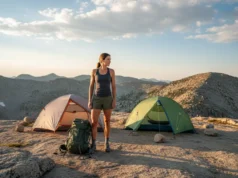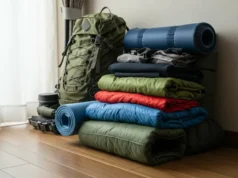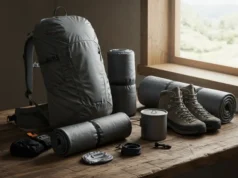In this article
Choosing a backcountry shelter often feels like a frustrating trade-off. You can carry a lighter pack, but you might sacrifice a good night’s sleep. You can haul in a comfortable setup, but your legs will pay the price on every ascent. The right hammock tent promises to end this compromise, offering a suspended sleep system that can revolutionize your comfort on the trail, far beyond a simple camping hammock. But navigating the world of asymmetrical cuts, complex suspension systems, and “lay-flat” technology can be overwhelming.
Let’s start by demystifying the critical features that define a great hammock tent shelter. Then, we’ll pull back the curtain on our rigorous field-testing process, showing you exactly what we look for in a top-tier hiking shelter. Finally, we’ll provide clear, data-driven recommendations tailored to your specific hiking style—whether you’re an ultralight thru-hiker, a comfort-focused weekender, or a gear-savvy novice ready to invest in the perfect hang.
What Truly Matters in a Hammock Tent?
To choose the right hammock tent, you need to look past the marketing hype and understand the features that directly impact your comfort and safety on the trail. Forget the buzzwords; focus on the functional engineering that makes or breaks a shelter system.
Why is Sleep Geometry a Hiker’s Most Important Choice?
Your experience in a hammock tent hinges on a single concept: sleep geometry. This is the fundamental design philosophy that dictates how you lie in the hammock. The choice boils down to a core dilemma: do you prefer to learn a skill for comfort, or invest in technology for comfort? A classic hammock, the traditional gathered-end model, represents the skill-based approach, requiring you to master a diagonal lay to achieve a relatively flat position. This technique is highly effective but must be learned. Within this world, an Asymmetrical (Asym) cut is tailored to optimize that diagonal lay for a flatter sleeping surface in one direction, while a symmetrical cut is more versatile for lounging but less specialized for sleeping.
On the other side are structured systems, like bridge hammocks, that use technology—such as spreader bars and integrated air mattresses—to create a naturally flat, cot-like platform. These “lay-flat” solutions are the superior choice for dedicated side and stomach sleepers who feel constrained by the “banana” curve of traditional designs, and distinguishing them from other suspended shelters like a multi-point tree tent from a brand like Tentsile. While hammock tents offer unique benefits, understanding how they compare to the best hiking tents is crucial for any shelter system decision.
What is “True Trail Weight” and Why is it Deceptive?
In the world of backpacking gear, weight is everything, but numbers can be misleading. Manufacturers often engage in a marketing ploy by advertising the weight of the hammock body alone. This is deceptive for a hiker who needs a complete shelter system. We define “True Trail Weight” as the combined, realistic weight of all essential components you must carry: the hammock itself, the suspension system, a bug net, the rainfly or tarp, and any necessary stakes and guylines.
A perfect example is the Kammok Mantis UL; the hammock body is just over 1 lb, a featherlight number that looks great on paper. However, the full, trail-ready hammock system weighs 2 lbs 7 oz. To provide honest, apples-to-apples evaluations, we exclusively use True Trail Weight for all our comparisons. Understanding this concept is a core principle of our philosophy on lightweight backpacking gear.
How Do Suspension Systems Affect Safety and Setup?
Your hammock is useless without a safe and reliable way to hang it, and your choice of suspension system impacts setup speed, weight, and your environmental footprint. The most critical factor is Leave No Trace compliance. To prevent damaging tree bark, you must use “tree-friendly” straps that are at least 1-inch wide. For beginners, Daisy Chains—webbing straps with multiple pre-sewn loops—are highly intuitive but are often heavier and offer less precise adjustment.
Ultralight hikers and ounce-counters often favor Whoopie Slings, an incredibly lightweight and adjustable cord-based system, but they come with a steeper learning curve. Offering an excellent middle ground, modern Buckle Systems provide a fantastic balance of low weight, high strength, and straightforward, secure adjustment. Adhering to Leave No Trace principles for hammock camping is non-negotiable for responsible outdoors-people. This is a key part of mastering outdoor ethics and Leave No Trace.
How We Tested and What We Looked For
To earn your trust, we believe in radical transparency. What follows is a detailed look at the rigorous evaluation process behind our recommendations, ensuring you know exactly how we arrived at our conclusions.
Our commitment to you is one of complete objectivity. Our recommendations are the result of independent research and intensive, hands-on testing. We are a reader-supported resource and never accept payment for product placement. Our only goal is to provide unbiased analysis that helps you find the absolute best gear for your next adventure.
Every hammock tent was judged against the critical performance attributes you just learned about. We built our evaluation framework around the three pillars that matter most on the trail: real-world comfort (Sleep Geometry), honest packed weight (True Trail Weight), and the safety and reliability of the Suspension System. We analyzed everything from the denier of the ripstop nylon to the waterproof rating of the rainfly to see how specs translate to performance in these advanced shelter systems.
Our real-world testing methodology is where the gear proves its worth. Each complete hammock tent system was field-tested by our team for over 40 nights across a range of challenging North American environments. We subjected these shelters to the humid, buggy forests of the Appalachian Trail and the windy, exposed ridgelines of the Rockies to see how they held up in the real world, not just a controlled lab setting.
The final step was to translate this wealth of performance data and trail notes into actionable advice. The entire goal of this rigorous process was to move beyond simple ratings and provide clear, practical recommendations. We’ve distilled our findings to help you—the comfort-seeker, the systems thinker, or the value-conscious novice—find the perfect match for your specific needs.
The Best Hammock Tents of 2025: Our Top Picks
Here are our field-tested recommendations. We’ve broken them down by the type of hiker you are and the specific problems you need your shelter to solve on the trail.
Best for The Comfort-Seeker
The Haven Tent XL represents the pinnacle of technology-based comfort, delivering a truly flat, stable, and spacious sleeping platform that feels more like a floating cot than a traditional hammock. Its patented design incorporates spreader bars and a required, integrated insulated air mattress (with an impressive R-value of 5.3) to create an unrivaled lay-flat surface, making it the undisputed champion for side and stomach sleepers. Built from durable 70D ripstop polyester, its design also offers incredible ground versatility, allowing it to be pitched as a bivy in treeless environments, from solid rock to soft sand. The trade-off for this bed-like comfort is a substantial True Trail Weight of over 6 pounds, making the Haven Tent XL best suited for shorter hikes or any trip where supreme sleep quality is the absolute top priority.
PROS
- True lay-flat sleep, like a bed
- Unmatched comfort for side sleepers
- Versatile ground and air setup
- Excellent insulation included
CONS
- Very heavy for long-distance hiking
- Premium price point
- Requires poles for ground setup
The Lawson Blue Ridge Camping Hammock is a time-tested veteran in the lay-flat category, offering a flatter and more open sleeping experience than any gathered-end design. This bridge-style hammock uses aluminum arch poles and spreader bars to create a tent-like canopy and significantly reduce the “banana” curve, providing a taut, comfortable sleeping surface. Its most compelling feature, however, is its unmatched versatility; this camping hammock tent functions equally well as a suspended hammock and a self-contained, one-person ground tent. This hybrid capability makes it an incredibly adaptable shelter. The primary trade-offs are weight and stability; at 4.25 pounds, it’s much heavier than ultralight models, and it can feel “tippy” until the side guylines are staked out properly.
PROS
- Flatter lay than traditional hammocks
- Excellent hybrid ground tent design
- Roomy, open interior feel
- Durable, well-built construction
CONS
- Heavy for ultralight backpacking
- Can feel unstable if not guyed out
- Suspension straps not included
Best for The Systems Thinker
The Kammok Mantis UL is the premier all-in-one hammock shelter system for the hiker who values thoughtful design and out-of-the-box simplicity. This kit removes all guesswork, providing a high-quality, ultralight shelter where every component is designed to work together seamlessly. The system includes the hammock (made from a light but strong Levitas™ 20D nylon ripstop), a removable Dragonet™ hammock bug net, a full-coverage Patagium™ tarp, and an intuitive, knotless “Python” daisy chain suspension system. With a True Trail Weight of just over 2 pounds, it’s a fantastic choice for backpackers looking to shed ounces without sacrificing a complete, protective shelter. While it’s one of the more expensive all-in-one kits, its main drawback is that the included tent stakes are prone to bending and represent a likely first upgrade for serious users.
PROS
- Superb ultralight all-in-one kit
- Extremely fast and intuitive setup
- Very compact and packable
- Thoughtful, integrated design
CONS
- Premium price for an integrated kit
- Included tent stakes are weak
- Python straps can stretch overnight
The Hennessy Expedition Asym Zip is an icon in the hammock world for good reason. It’s a time-tested, incredibly durable, and complete tent hammock system that offers unbeatable value, making it the benchmark for anyone entering the world of quality hammock camping. Its performance is rooted in a patented asymmetrical design and a structural ridgeline, which work together to guarantee a comfortable and flat diagonal lay every time. Constructed from robust 70d high-density nylon taffeta, this integrated kit is built to last for years of hard use. The primary trade-off is that the included diamond-shaped rainfly is on the smaller side and offers minimal protection in heavy, wind-driven rain. For this reason, upgrading to a larger tarp is a very common and highly recommended modification for four-season use.
PROS
- Incredible performance for the price
- Proven, highly durable construction
- Patented comfortable asymmetrical lay
- A complete, field-ready system
CONS
- Stock rainfly offers minimal coverage
- Rope suspension has a learning curve
- Included tree straps are short
Final Considerations & Common Mistakes to Avoid
Before you click “buy,” a few final pieces of expert advice can ensure your investment pays off in trail comfort for years to come. Thinking through these points now will prevent frustration in the field later.
First and foremost, don’t forget insulation. The chilling reality of “Cold Butt Syndrome” is the most common mistake new enthusiasts make in hammock camping. Air circulating beneath you will rob you of warmth, even on cool summer nights. A hammock tent requires an underquilt or a compatible sleeping pad for bottom insulation in all but the very warmest tropical conditions. This is a non-negotiable part of a functional sleep system.
Next, understand the path you’re choosing for your hammock tent camping setup: a kit or a custom build. An all-in-one kit like the Kammok Mantis UL offers brilliant simplicity and guaranteed compatibility, but less flexibility for future upgrades. A modular, custom system requires more initial research but allows you to adapt, upgrade, and fine-tune every component—from the suspension to the tarp—as your skills and needs evolve, far beyond what’s possible with most integrated tent shelter systems.
[PRO-TIP] Never wait until you’re deep in the backcountry at dusk to set up your new shelter for the first time. Practice in a local park or your backyard to dial in the perfect 30-degree hang angle and master your specific suspension system.
Finally, always check the return policy. Gear preference, especially for something as personal as a sleep system, is subjective. When buying a hammock with a unique feel, like a lay-flat or bridge model, ensure the manufacturer has a solid return policy or satisfaction guarantee. This gives you the confidence to test the feel for yourself and be certain you’ve made the right choice.
Frequently Asked Questions about Hammock Tents
Can you sleep on your side in a hammock tent?
Yes, but your choice of hammock is critical. For comfortable and consistent side-sleeping, you must choose a “lay-flat” model that uses technology like spreader bars or a structured, padded base. The best options for this are the Haven Tent XL and the Lawson Blue Ridge Camping Hammock.
Do you need an underquilt with a hammock tent?
Yes, you almost always need bottom insulation to prevent convective heat loss, a phenomenon known as “Cold Butt Syndrome.” An underquilt is the most effective and comfortable solution. Some integrated systems, like the Haven Tent, are designed around a mandatory insulated sleeping pad that serves the same purpose.
Are hammock tents fully waterproof?
Yes, a complete hammock tent shelter is designed to be fully waterproof. The weather protection depends entirely on the size, quality, and setup of the included rainfly (tarp). All-in-one kits like the Kammok Mantis UL or Hennessy Expedition Asym Zip provide a tarp designed to offer full coverage from rain.
What is a good weight for a complete hammock tent system?
This depends entirely on your priorities. A good ultralight system will have a True Trail Weight between 2 and 3 pounds. Comfort-focused systems that offer a true lay-flat experience can weigh over 6 pounds. Ultralight hikers should look at models like the Kammok Mantis UL, whereas those prioritizing sleep quality above all else will find the weight of a system like the Haven Tent XL to be a worthwhile trade-off.
Risk Disclaimer: Hiking, trekking, backpacking, and all related outdoor activities involve inherent risks which may result in serious injury, illness, or death. The information provided on The Hiking Tribe is for educational and informational purposes only. While we strive for accuracy, information on trails, gear, techniques, and safety is not a substitute for your own best judgment and thorough preparation. Trail conditions, weather, and other environmental factors change rapidly and may differ from what is described on this site. Always check with official sources like park services for the most current alerts and conditions. Never undertake a hike beyond your abilities and always be prepared for the unexpected. By using this website, you agree that you are solely responsible for your own safety. Any reliance you place on our content is strictly at your own risk, and you assume all liability for your actions and decisions in the outdoors. The Hiking Tribe and its authors will not be held liable for any injury, damage, or loss sustained in connection with the use of the information herein.
Affiliate Disclosure: We are a participant in the Amazon Services LLC Associates Program, an affiliate advertising program designed to provide a means for us to earn advertising fees by advertising and linking to Amazon.com. As an Amazon Associate, we earn from qualifying purchases. We also participate in other affiliate programs and may receive a commission on products purchased through our links, at no extra cost to you. Additional terms are found in the terms of service.





